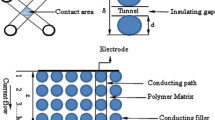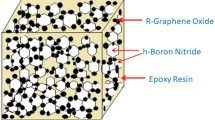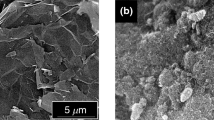Abstract
Composite films made of poly(vinylidene fluoride) (PVDF) and conducting particles of carbon black (CB) were prepared using a hot press. Using different volume fractions of CB filler, electrical properties of the samples were analyzed with current–voltage (I × V) measurements and impedance spectroscopy. To help the discussion, percolation theory and simulation circuits based on Colie diagrams were used. The percolation threshold was found at 3 vol% of CB. At these volume fractions of filler, scanning electron microscopy (SEM) images showed connected particles in the polymer matrix, while in the higher volume content of filler, the particles started to form clusters. Furthermore, it was observed that increasing volume fractions up to 3 vol%, the Young’s modulus and the tensile strength of the composite film were higher than that of the pure polymer, although the rupture strain was decreased. Composite films with 3 vol% of CB showed optimized electrical and mechanical properties and may be useful as an electrostatic dissipater.









Similar content being viewed by others
References
Aal NA, El-Tantawy F, Al-Hajry A, Bououdina M (2007) New antistatic charge and electromagnetic shielding effectiveness from conductive epoxy resin/plasticized carbon black composites. Polym Compos 29(2):125–132
Strümpler R, Glatz-Reichenbach J (1999) Conducting polymer composites. J Electroceram 3(4):329–346
Arlindo EPS, Lucindo JA, Bastos CMO, Emmel PD, Orlandi MO (2012) Electrical and optical properties of conductive and transparent ITO@PMMA. Nanocompos J Phys Chem C 116(23):12946–12952
Liang J, Yang Q (2007) Aggregate structure and percolation behavior in polymer/carbon Black conductive composites. J Appl Phys NY 102:083508.1–083508.5
Li F et al (2000) Polyurethane/conducting carbon black composites: structure, electric conductivity, strain recovery behavior, and their relationships. J Appl Polym Sci NY 75:68–77
Bunde A, Dieterich W (2000) Percolation in composites. J Electroceram Dordr 5(2):81–92
Da Silva MJ, Kanda DHF, Nagashima HN (2012) Mechanism of charge transport in castor oil-based polyurethane/carbon black composite (PU/CB). J Noncryst Solids 358:270–275
Calister WD, Rethwisch DG (2010) Materials science and engineering, 8th edn. Wiley, New York
Jing X, Zhao W (2000) The effect of particle size on electric conducting percolation threshold in polymer/conducting particle composites. J Mater Sci Lett Lond 9:377–379
Fu S-Y, Feng X-Q, Lauke B, Mai Y-W (2008) Effects of particle size, particle/matrix interface adhesion and particle loading on mechanical properties of particulate–polymer composites. Compos Part B 39:933–961
Berkowitz B, Ewing RP (1998) Percolation theory and network modeling applications in soil physics. Surv Geophys Dordr 19(1):23–72
Yang QQ, Liang JZ (2008) A percolation model for insulator-metal transition in polymer-conductor composites. Appl Phys Lett NY 93:131918.1–131918.3
Derrida B, Zabolitzky JG, Vannimenus J, Stauffer DJ (1984) A transfer matrix program to calculate the conductivity of random resistor networks. J Stat Phys 36:31
Lovinger AJ (1982) Poly(Vinylidene Fluoride). In: Basset DC (ed) Developments in crystalline polymers—1, vol 33. Springer, Netherlands, pp 195–273
Balberg I (2001) A comprehensive picture of the electrical phenomena in carbon black—polymer composites. Carbon 40:139–143
Probst N, Grivei E (2002) Structure and electrical properties of carbon black. Carbon 40:201–205
Zhao Z, Yu W, He X, Chen X (2003) The conduction mechanism of carbon black filled poly(vinylidene fluoride) composite. Mater Lett 57:3082–3088
Li F, Qi L, Yang J, Xu M, Luo X, Ma D (1999) Polyurethane/conducting carbon black composites: structure, electric conductivity, strain recovery behavior, and their relationships. J Appl Polym Sci 75(1):68–77
Jonscher AK (1977) The universal dielectric response. Nature Lond 267(5613):673–679
Cole RH (1965) Relaxation processes in dielectrics. J Cell Comp Physiol NY 66(3):13–25
Hamon BV (1952) An approximate method for deducing dielectric loss factor from direct-current measurements. Proc IEEE Part IV Monograph 27:151–155
Acknowledgments
Thank you to Fundação de Amparo à Pesquisa do Estado de Mato Grosso (FAPEMAT) for the financial support. WKS also thanks Fundação de Amparo à Pesquisa do Estado de São Paulo (FAPESP) (CEPID 2013/07296-2 and INCTMN 2008/57872-1) and Conselho Nacional de Desenvolvimento Científico e Tecnológico (CNPq) (INCTMN 573636/2008-7).
Author information
Authors and Affiliations
Corresponding author
Rights and permissions
About this article
Cite this article
Deniz, W.D.S., Sousa, E.A., Arlindo, E.P.S. et al. Electrical and mechanical characterization of a flexible conducting composite. Polym. Bull. 72, 1787–1797 (2015). https://doi.org/10.1007/s00289-015-1371-y
Received:
Revised:
Accepted:
Published:
Issue Date:
DOI: https://doi.org/10.1007/s00289-015-1371-y




